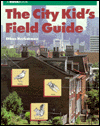
Take a look at the photo above. You'd be surprised at how much nature you could actually observe there.
When we live in the city, we tend to forget that nature is
still all around us. It’s hard to find wildlife such as animals, insects, and
plants, when huge buildings, neverending concrete sidewalks, and artificial
lights steal your attention. But the nature is still there, it’s just not as
obvious.
The City Kid’s Field Guide by Ethan Herberman.
This guide contains all you need to know to find an abundance of wildlife that still exists within our man-made cities. Just because you live in the city doesn’t mean
you can’t observe nature firsthand!
The book is broken into five categories:
- The Wild Indoors – all the insects and rodents you could find in your home
- In Your Own Backyard – common animals, plants, and insects you will find just outside your door
- Deepest Downtown – believe it or not, lots of plants and animals have adapted to downtown life
- Park or Ark? – the more obvious place to find wildlife, including larger birds and mammals
- Vacant Lots? – they aren’t really vacant, but filled with plants and insects
What’s great about The City Kid’s Field Guide:
- It gives you a whole new perspective on where you can find nature: everywhere!
- It gives lots of information on how animals have adapted to human development: plants growing through cracks in sidewalks, raccoons eating our trash, falcons nesting on skyscrapers, etc.
- Like a real field guide, you can look for and easily identify lots of common, city dwelling animals and plants.
What’s lacking:
- This is a purely informational book; you won’t find any activities here.
- It has a lot of text and requires a third-grade reading level, so little ones may not be interested.
As a teacher:
I would love to have this book around. It’s a
great reference and really inspires me to create activities based on
nature that we can find just outside the front door. I don’t need a trip to the zoo
or local nature preserve to get my students excited about nature. It's
literally right under our nose! Plus, it’s a great resource for animal
adaptations. On every page, you will learn about at least one animal and an
adaptation. The next time I teach about the environment, I’m sending a
checklist home of all the species of plants and animals mentioned in the guide for the students to
try to spot at their home.
As a parent:
It could be a great resource to help you guide
your children to exploring the outdoors. Read the book together, create checklists and go exploring together to see firsthand everything the book describes.
Since the book is focused on city-dwelling wildlife, it should be easy, fun, and
quick to find something to observe. Think about it: these animals are already accustomed
to loud noises and people moving around. It’s not so easy to scare them off
before you get a chance to take a photo.
This book is just one of the many resources found in the
USEE teacher resource center. If you are a formal or informal educator of any
kind, I encourage you to stop by our office and see what other resources we
have on our shelves.
Not a teacher, or not in the area? Your local library can
help you find the The City Kid’s Field Guide and many others.
I know staring out my house windows just got a little more
interesting, thanks to this book.
-Holly

No comments:
Post a Comment